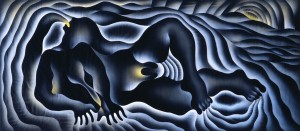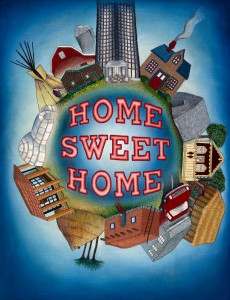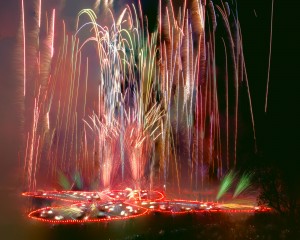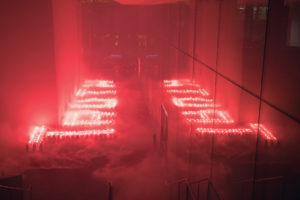Born July 20, 1939 – Chicago, IL
After six decades of professional practice, Judy Chicago had her first retrospective at the de Young Museum in San Francisco, brilliantly curated by Claudia Schmuckli. This exhibition finally achieved Chicago’s goal of having the body of her art emerge from the shadow of The Dinner Party which – until then, had defined her career. The reviews were rapturous, stressing what a ‘revelation’ it was to see the range of subject matter and technique that has defined her journey as an artist. One month before the retrospective, Thames and Hudson published The Flowering, Chicago’s definitive autobiography with a Forward by Gloria Steinem. Together, these events marked a turning point in the way in which Judy Chicago’s work is perceived.
During her often tumultuous, challenging and sometimes controversial career Chicago pioneered Feminist art and art education through a unique program for women at California State University, Fresno, a pedagogical approach that she has continued to develop over the years. In 1974, Chicago turned her attention to the subject of women’s history to create her most well-known work, The Dinner Party, which was executed between 1974 and 1979 with the participation of hundreds of volunteers. This monumental multimedia project, a symbolic history of women in Western Civilization, has been seen by more than one million viewers during its sixteen exhibitions held at venues spanning six countries.
The Dinner Party has been the subject of countless articles and art history texts and is included in innumerable publications in diverse fields. The impact of The Dinner Party was examined in the 1996 exhibition, Sexual Politics: Judy Chicago’s Dinner Party in Feminist Art History. Curated by Dr. Amelia Jones at the UCLA Armand Hammer Museum, this show was accompanied by an extensive catalog published by the University of California Press. Jones’ analysis has been updated and expanded in historian Jane Gerhard’s book The Dinner Party: Judy Chicago and the Power of Popular Feminism, 1970-2007, published by the University of Georgia Press. In 2007, The Dinner Party was permanently housed at the Brooklyn Museum as the centerpiece of the Elizabeth A. Sackler Center for Feminist Art, thereby achieving Chicago’s long-held goal. Recently, Chicago published a final updated book, The Dinner Party: Restoring Women to History (The Monacelli Press, 2014).
From 1980 to 1985, Chicago worked on the Birth Project. Having observed an absence of iconography about the subject of birth in Western art, Chicago designed a series of birth and creation images for needlework which were executed under her supervision by 150 skilled needle workers around the country. The Birth Project, exhibited in more than 100 venues, employed the collaborative methods and a similar merging of concept and media that characterized The Dinner Party. Exhibition units from the Birth Project can be seen in numerous public collections around the country.

Judy Chicago, Earth Birth, 1983, sprayed Versatex and DMC floss on fabric, 62.5 x 132.2 in., quilting by Jacquelyn Moore Alexander, collection of Longlati Foundation, China.
While completing the Birth Project, Chicago also focused on individual studio work to create PowerPlay. In this unusual series of drawings, paintings, weavings, cast paper, and bronze reliefs, Chicago brought a critical feminist gaze to the gender construct of masculinity, exploring how prevailing definitions of power have affected the world in general — and men in particular. The thought processes involved in PowerPlay, the artist’s long concern with issues of power and powerlessness, and a growing interest in her Jewish heritage led Chicago to her next body of art.
The Holocaust Project: From Darkness Into Light premiered in October 1993 at the Spertus Museum in Chicago, then traveled to museums around the United States until 2002. Selections from the project continue to be exhibited. The Holocaust Project involved eight years of inquiry, travel, study, and artistic creation. It is comprised of a series of images merging Chicago’s painting with the innovative photography of Donald Woodman, as well as works in stained glass and tapestry designed by Chicago and executed by skilled artisans.

Judy Chicago, Home Sweet Home from Family, 2000, sprayed acrylic, oil paint, and embroidery on linen, 24 x 18 in., needlework by Pamella Nesbit, private collection.
Resolutions: A Stitch in Time was Judy Chicago’s last collaborative project. Begun in 1994 with skilled needle workers with whom she had worked for many years, Resolutions combines painting and needlework in a series of exquisitely crafted and inspiring images which – with an eye to the future – playfully reinterpret traditional adages and proverbs. The exhibition opened in June 2000 at the Museum of Art and Design, New York, NY, and was toured to seven venues around the United States and Canada.
In 2011 and 2012, Chicago’s important contributions to southern California art were highlighted in Pacific Standard Time, a Getty funded initiative documenting and celebrating the region’s rich history. She was featured in eight museum exhibitions and kicked off the Getty PST Performance Festival with the restaging of two events, Sublime Environment (a dry ice installation) and A Butterfly for Pomona, the first fireworks piece Chicago had done since 1974. This reevaluation of her work has led to renewed interest around the United States and Europe.

Judy Chicago, A Butterfly for Brooklyn, 2014, fireworks, flares and LED lights, Prospect Park, Brooklyn, NY, staged by Pyro Spectaculars by Souza.
In 2014, in honor of Chicago’s 75th birthday, a series of exhibitions and events were held around the country at various institutions and galleries including the Palmer Museum at Penn State University (where there was a semester-long, campus wide celebration of Chicago’s art education archive which was acquired by the university in 2011); the National Museum of Women in the Arts; the Schlesinger Library on the History of Women in America at the Radcliffe Institute/Harvard; Mana Contemporary, Jersey City, sponsored by Nyehaus; the Elizabeth A. Sackler Center for Feminist Art, Brooklyn Museum; the New Mexico Museum of Art; David Richard Gallery in Santa Fe; and Redline in Denver. Her birthday year was capped off on April 26th when she presented, A Butterfly for Brooklyn. This complex pyrotechnic work in Prospect Park was attended by 12,000 people who – at the end of the performance – burst into spontaneous applause followed by singing “Happy Birthday.”
2015 brought the inclusion of her work in multiple museum exhibitions in Krakow, London, Milan and Bilbao, Spain where the feminist curator Xabier Arakistain mounted Why Not Judy Chicago?, an overview of Chicago’s career and an inquiry into the ongoing institutional resistance to Chicago’s work. In 2016, the show traveled to CAPC in Bordeaux, France.

Judy Chicago, Be No More, 2017, dry ice and flares, work was created in conjunction with SFMOMA for their inaugural “Birthday Bash” and Jessica Silverman Gallery. San Francisco, CA.
In 2017, Chicago completed her fourth dry-ice installation titled, Be No More, for SFMOMA’s one year anniversary “Birthday Bash” and was commissioned by Tate Liverpool to create the spectacular, gigantic mural titled “Four Lads from Liverpool” to commemorate the 50 year anniversary of the Beatles’ album, Sgt Pepper’s Lonely Heart’s Club Band. Later in 2017, Chicago had solo exhibitions at Jessica Silverman Gallery in San Francisco, The Brooklyn Museum in New York, and the National Museum of Women in the Arts (NMWA) in Washington DC. The Brooklyn Museum and NMWA shows examined for the first time her creative process in The Dinner Party and explored the feminist studio environment she established.
Chicago’s most recent body of work titled, The End: A Meditation on Death and Extinction, premiered at the National Museum of Women in the Arts in Fall 2019, shortly after the release of a major monograph published by Scala in conjunction with NMWA, Salon 94, and Jessica Silverman Gallery. In 2018 Chicago was named one of Time Magazine’s “100 Most Influential People” and one of Artsy Magazine’s 2018 “Most Influential Artists.” In 2019, she received the Visionary Woman award from the Museum of Contemporary Art in Chicago and was an honoree at the annual Hammer Museum gala in Los Angeles. In 2020 she was honored by the Museum of Arts and Design at their annual MAD Ball. Her first career retrospective opened in August 2021 at the de Young Museum in San Francisco where she was honored at the museum’s annual gala.
Among many other institutions, Chicago’s work is in the collections of the British Museum, Moderna Museet (Stockholm), Tate Modern (London), Muzeum Susch (Switzerland), Centre Pompidou (Paris), Whitney Museum, Los Angeles County Museum of Art, Museum of Contemporary Art Los Angeles, Hammer Museum, Getty Trust and Getty Research Institute, San Francisco Museum of Modern Art, Crystal Bridges Museum of American Art, Art Institute of Chicago, the Nasher Sculpture Center, and the Smithsonian American Art Museum. Working with the artist since 2000, the National Museum of Women in the Arts has organized four exhibitions and developed a core collection of Chicago’s art. NMWA is the repository for her Visual Archives, a partner in the Judy Chicago Research Portal project, and published the artist’s monograph Judy Chicago: New Views in 2019.
In addition to a life of prodigious art making, Chicago is the author of numerous books: Through the Flower: My Struggle as a Woman Artist, 1975 (subsequently published in England, Germany, Japan, Taiwan, China, and France) and most recently made available as an e-book; The Dinner Party: A Symbol of Our Heritage, 1979; Embroidering Our Heritage: The Dinner Party Needlework, 1980 (also published in a combined edition in Germany); the Birth Project, 1985 (Anchor/Doubleday); Holocaust Project: From Darkness into Light, 1993; The Dinner Party / Judy Chicago, 1996; Beyond the Flower: The Autobiography of a Feminist Artist, 1996 (Viking Penguin); Fragments from the Delta of Venus, 2004 (powerHouse Books) and Kitty City: A Feline Book of Hours, 2005 (Harper Design International). In 2014, Institutional Time: A Critique of Studio Art Education, was also published by The Monacelli Press. Her newest book, The Flowering: The Autobiography of Judy Chicago, published by Thames and Hudson and with an introduction by Gloria Steinem, was released in July 2021. Penn State has established an on-line research portal that created online access to all five of her archives (judychicagoportal.org).
For over five decades, Chicago has remained steadfast in her commitment to the power of art as a vehicle for intellectual transformation and social change and to women’s right to engage in the highest level of art production. As a result, she has become a symbol for people everywhere, known and respected as an artist, writer, teacher, feminist and humanist whose work and life are models for an enlarged definition of art, an expanded role for the artist, and women’s right to freedom of expression.
For more information about Judy Chicago’s work, please visit www.JudyChicago.com and www.throughtheflower.org.
All artwork © Judy Chicago/Artists Rights Society (ARS), New York.